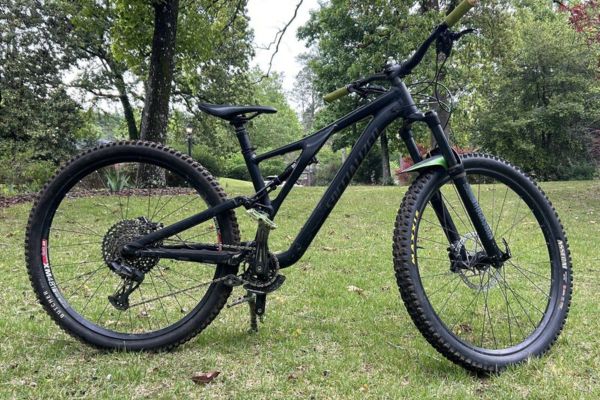What Causes Bike Tires to Warped (Easy Fix)
Warped bicycle tires can pose a significant challenge for cyclists of all skill levels. Fortunately, fixing this issue can be relatively straightforward. But first, let’s understand why you face tire warp issues.
Here are a few reasons that cause bike tires to warp –
- The tire is not seated properly making it look hop.
- Uneven tension in the spokes causes wobbling or deformation.
- Impact damages.
- Overinflating of tires.
To quickly get back on your bike, we aim to uncover the underlying causes of these problems and offer you effective solutions.
What causes Bike Tires to be Warped?
I see a lot of this in our shop; trust me, most of the time, the wheel is just fine. Here are the four causes with solutions to fix your warped bike tires.
Check if the Tire is Seated Properly
When encountering warped bike tires, it’s crucial to consider whether the tire is seated correctly. Start by checking the alignment of the tire casing; most tires have lines that sit equidistant from the rim. If this line isn’t even, the tire’s casing may look like a hop, creating the illusion of a faulty wheel.
Additionally, look for tire casing shifts or separation from the tread, often caused by significant impacts like potholes or jumps. When dealing with a new wheel, these factors should be your primary focus before attributing the issue to the wheel itself.
Uneven Tension in Spokes
Uneven tension in spokes can be a significant factor causing bike tires to become warped. When the spokes lack proper tension, it weakens the overall structure of the wheel, making it susceptible to deformations and wobbling. The problem worsens when the tension in the spokes is uneven, as this instability can further compromise the wheel’s performance.
To ensure your wheel is in optimal condition, checking the spoke tension is essential. You can listen to their sound when tapped or lightly struck. Properly tensioned spokes should produce a high-pitched sound, and it’s crucial to aim for uniformity in this sound across all spokes.
Given its design and materials, achieving good and equal tension in spokes is essential for maximizing the strength and stability of your wheel. If you need more clarification about your ability to gauge tension by sound, apps are available to help you measure sound frequency and ensure consistency among all spokes.
Impact Damage
Impact damage can cause real damage to your bike tires. Those sneaky potholes, obstinate curbs, and adrenaline-pumping jumps can all throw your ride off balance. So, after hitting any significant bump, make it a habit to play detective and inspect your tires and rims for damage, dents, or bends. Want to level up your protection game?
Add rim protection and adapt your riding style to minimize those heart-stopping moments.
Remember, keeping up with regular maintenance is key to a winning ride. And for those epic challenges, consult a pro bike mechanic who can ensure you’re always on the winning side of the game, ensuring safe and smooth rides on your two-wheeled companion.
Overinflating the Tires
Overinflating the tires can also cause your bike tires to warp. It means the tires are pumped with air pressure beyond recommended levels, often due to misinformation or carelessness.
Tire wrapping unfolds as overinflated tires lose flexibility, reducing road contact. This condition causes several issues, including decreased traction, a rough ride, and the looming threat of tire failure.
To prevent tire wrapping and ensure safe cycling experiences, cyclists must adhere to manufacturer-prescribed pressure guidelines, employ accurate pressure gauges, perform routine tire checks, and spread awareness within the cycling fraternity.
You should just check out all these factors before changing a tire or wheel completely.
Is the Low Quality of Tires Responsible for Warping?
The quality of tires can affect their performance and durability, but “warping” is not a typical issue with tires. Low-quality tires may be more prone to damage, such as uneven tread wear, sidewall bulges, or susceptibility to pothole damage. Proper tire maintenance is essential for prolonging tire life and performance, regardless of their quality. If you suspect tire damage or wear, have them inspected by a professional.
How to Fix Warped Tires?
Fixing a warped bicycle tire might seem tricky, but it’s easier. Here’s a simple guide to get your bike rolling smoothly again:
Step 1: Flip your bike upside down to see the damaged wheel easily. Spin the wheel gently and mark the spot where it’s not moving smoothly.
Step 2: Use a pencil or chalk to mark the troublesome area. Identify three spokes on each side of your mark. See which way the wheel is bending – left or right.
Step 3: Tighten the spokes on the side where the wheel is bent and loosen the ones on the opposite side. A quarter-turn at a time should do it. If the wheel still rubs against the brakes, repeat until it’s balanced.
Step 4: Test your wheel by taking a short ride to ensure it’s rolling smoothly.
That’s it! You’ve successfully fixed your bike tire and can enjoy your ride without any trouble.
FAQs
Does Cold Weather Warped My Bike Tire?
No cold weather alone typically doesn’t warp bike tires, but it can affect rubber stiffness and tire pressure. Ensure proper inflation, store your bike in controlled conditions, and maintain high-quality tires to prevent damage. If you suspect warping, consult a professional mechanic.
Can you Ride a Bike with Warped Tires?
Yes, but no. It is not advisable to ride a bike with warped tires. This puts your safety, handling, and bike’s health at risk. Having warped tires can lead to instability, reduced traction, and increased wear. Your biking efficiency suffers, too. It’s best to address the issue promptly by adjusting the wheels or seeking professional help for safe and enjoyable rides.







